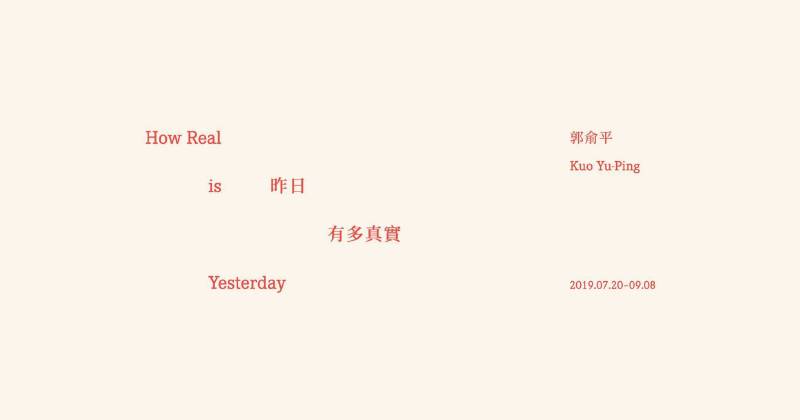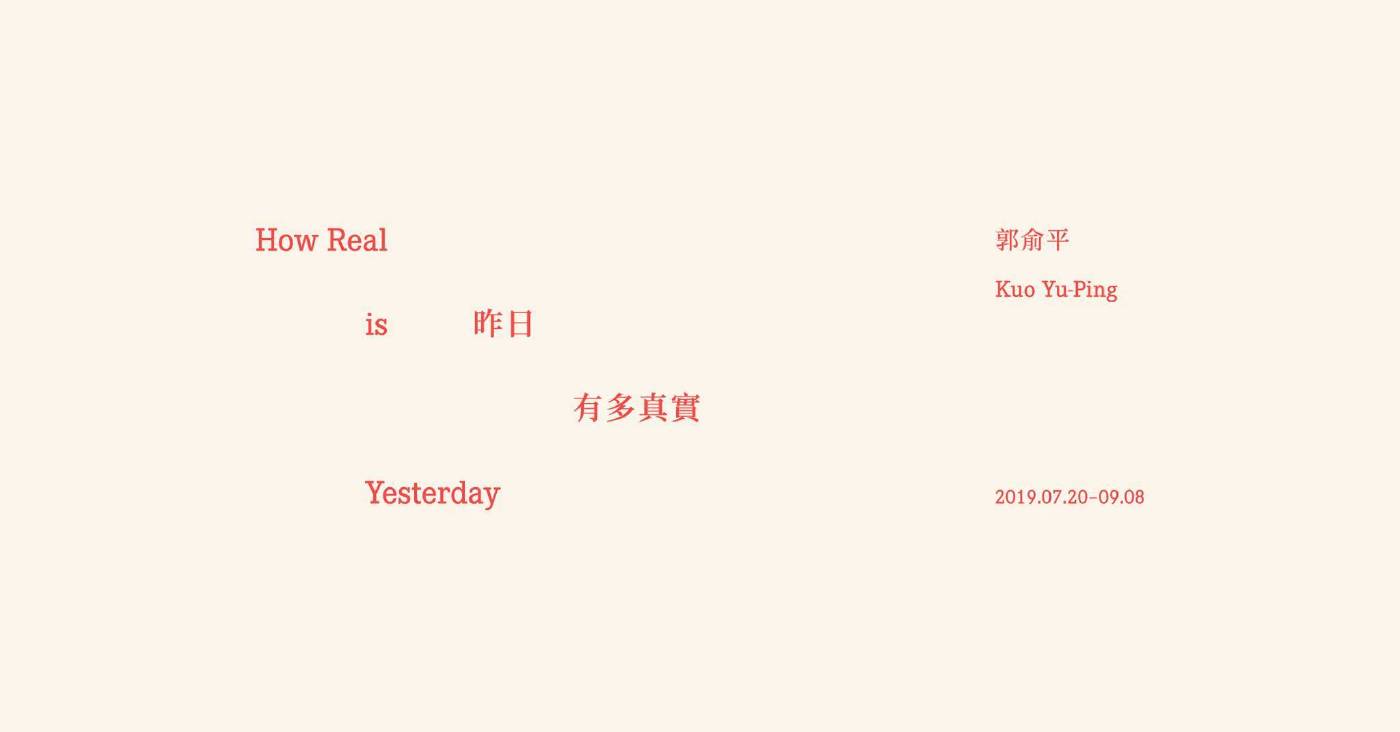TKG+
【昨日有多真實】郭俞平個展

-
展期
日期:2019-07-20 ~ 2019-09-08
-
地點
台北市內湖區瑞光路15號台灣 548 巷 B1
-
參展藝術家
郭俞平
-
童年家屋是一棟生長在郭俞平意識中無限延伸的房子,對於家的記憶的呈現,她總有一股炙熱感與濃得化不開的愁緒。此次在TKG+ Projects的個展,藉著梳理過去的作品,進而更富饒心中的家屋,整個展場可視為她內在心靈圖景的一種具象化,每一件作品則幽幽的發出一些聲音,像是一個夢境中的公園。《雙重閱讀》是郭俞平於展場所拍攝的錄像作品,透過儀隊曾經在場的視像,試圖往內心深處不斷的挖掘彷彿存在於潛意識的意念,展示出某些難以言明、幽靈般的自我審查狀態。
郭俞平與家人因父親退休而搬離了從小成長的中興新村,對家中物件與光線有著深刻的依戀,這樣的生命事件使她萌生在創作中尋根的念頭。郭俞平以記憶作為解析刺點的途徑,在2013年作品《延遲與凹洞》中,除了自我追尋之外,亦藉由探討政治結構位移對地方現代化發展的影響。中興新村是國民黨在大陸時期的「南京首都計畫」的延遲想像,永遠的硬體先行政策,隨之而來的是軟體的不足、文化的空缺。新作《一覺醒來》可視為郭俞平記憶的混雜性呈現,巨大的雨、污水分流下水道水循環系統,上方佇立著中興大會堂這棟俯瞰像轟炸機的五零年代建築,像是失落飛機的現代性的寓言,同時也是郭俞平對家鄉的空間記憶,而這龐大量體在展場中的隱蔽與不可見,便是她心靈狀態的一種投射。
自2016年開始,郭俞平以一種極為緩慢、自我折磨、神經質的方式開始拆解一張地毯,將仔細解開的棉線、鬆脫的羊毛,藉由不斷重複、儀式般的勞動,轉化為一顆顆實心的毛球。時間長了,身體也開始發展出能夠達到最有效率的運動方式,連續幾個鐘頭維持著同樣的姿勢,只有雙手的肌肉劇烈地運動著,身體彷彿進入一種真空狀態,既不生長、也不變老。各種情緒與記憶的殘片,有時像稀微的雪花般一閃即逝,有時則像大雨般下了一整天,直到產生一種苦澀的信念,以為控制了時間,彷彿可以一直這樣繼續拆解下去。這張地毯作為郭俞平創作脈絡中物件的延續與勞動行為上的不間斷,在去年作品《睡著,夢著,在昏熱的沃土》中結合了聲音來呈現出人存在的本質狀態—睡、吃與勞動的持存,無論是身體或心靈上的勞動。拆地毯的聲音、進食與睡眠的聲音、情緒波動的聲音,勾勒出人們不斷重複的生命狀態。
在整面落地窗的場域中,郭俞平營造了一個曖昧不明的時空,猶如她的內在精神界域。展場中表達不同心理結構的裝置,試圖組織出多重的辯證,像是她探討何為真實的備忘錄。「認同」究竟是被當作某種可閱讀的,還是可經歷的事物?再次的,她將整個場域設計為事件的演出場所。何為真實?此時此刻的告白,是偽妄亂真,還是補闕拾遺?
關於郭俞平
1986年出生於南投,現居住和工作於台北。郭俞平的作品善於透過自己的生命經驗,探尋集體意識與既有之社會、文化政治之間的關係,並將之轉化為具有詩意的敘事體,形成自己生命的面貌。她的作品涉及錄像、裝置、繪畫與行為,近年重要的作品《延遲與凹洞》、《中山高》、《自治權》凝注於對生命過程創傷意象的書寫,探索東亞在晚近的歷史條件下,集體意識裡形成「缺」的真實感。她的作品猶如自身的「認同計畫」,然而認同的懸缺又在作品中形成一種引人入勝的張力。
近年參與「台灣美術雙年展-野根莖」,國立台灣美術館,台中,台灣(2018);「台北美術獎」台北市立美術館(2018),台北,台灣;「 黑船、文明,芻言和_____ 的足跡:從近代日本到東亞當代藝術」,日動畫廊,台北,台灣(2018);「前程也許在遙遠的地方, 離別也許不會在機場,只要你說出一個未來」,谷公館,台北,台灣(2018);「菸葉、地毯、便當、紡織機、穴居人:當代藝術中的工藝及技術敘事」,鳳甲美術館,高雄,台灣(2017);「熱帶氣旋」,關渡美術館,台北,台灣(2017);「破碎的神聖」,台北當代藝術館,台北,台灣(2017);「伏流‧書寫」,台北市立美術館,台北,台灣(2017);「Family Reunion」,Pi Artworks Gallery,倫敦,英國(2017);「小黑書-郭俞平個展」,谷公館,台北,台灣(2017);台北雙年展「當下檔案・未來系譜」,台北市立美術館,台北,台灣(2016)。
----
How Real Is Yesterday ― Kuo Yu-Ping Solo Exhibition
Dates|2019.07.20 - 09.08
Reception| 2019.07.20 (Sat.) 04:30 p.m.
Venue│TKG+ Projects (2F, No. 15, Ln. 548, Ruiguang Rd., Neihu Dist., Taipei, Taiwan 114)
The childhood home of Kuo Yu-Ping’s is one that extends endlessly in her consciousness. Scorching heat and unbearably intense melancholy are always present in her representation of memories of home. How Real Is Yesterday, her first solo exhibition at the TKG+ Projects, inquires into Kuo’s previous body of work through a subtle and complex narrative that revolves around her idea of home. The entire exhibition space embodies her inner landscape, like a park in a dream where each work softly whispers. Double Reading (2019), a video work shot on site at the space, attempts to excavate what lies deep within the artist’s subconscious via images of once-present honor guards, eliciting an inexplicable, haunting state of self-censorship.
Upon her father’s retirement, Kuo and her family left the Zhongxing New Village in Nantou, Taiwan, where she grew up. Stirring a deep attachment to objects and light in her old home, her departure inspired her to search for her roots through art making. In Delay and Pit (2013), memory as an analytic approach of inquiry is used not only for the quest for her identity, but also for the investigation on how structural changes in politics cast an influence on local developments in the course of modernization. The Zhongxing New Village is a delayed projection of KMT’s then “Nanjing Capital Project” back in China. The policy of “infrastructure first” results in significant insufficiency in all other aspects, such as a deserted cultural scene. A new work Is Waking Up (2019), on the other hand, can be considered a hybrid representation of Kuo’s memories — pouring rain and a sewage system with waste water running through, on top of which stands the Zhongxing Auditorium, an architecture of the 50s that looks like a bomber aircraft from a bird’s eye view. It is an allegory of modernity telling the story of a lost plane. It is, too, the artist’s spatial memory of her hometown. Encircled by wooden walls yet present in the exhibition space, the enormous object’s ostensible invisibility closely corresponds to the artist’s state of mind.
Starting in 2016, Kuo began dismantling a piece of carpet in an extremely prolonged, self-torturing, and neurotic manner. Through repetitive and almost ritualistic manual labor, she carefully pulled the threads apart, loosened the wool, and turned them into numerous solid pom-poms. Over time, her body developed a movement pattern most efficient for the task. She could stay in the same position for hours with both arms being the only body parts that frantically moved. It is as if the whole body was isolated in a vacuum, without growing or aging. Continuing the trajectory of Kuo’s artistic practice, this piece of carpet, as an object echoing the motif of ceaseless labor, is part of the sound installation Sleep, Dream, in a Feverish Land (2018). The work attempts to capture the essence of human existence — perpetually engaged in activities of sleeping, eating, and laboring (both physically and mentally). The sound of dismantling carpet, of eating and sleeping, of emotional fluctuations, portrays the never-ending repetition in human life.
In the space with a whole wall of floor-to-ceiling windows, an ambivalent, unsettled sphere like that of the artist’s inner world is invoked. The installations in the exhibition represent the manifold states of the mind while spurring complex dialectical discussions, readily viewed as Kuo’s memorandum on her investigation of what reality is.
About Kuo Yu-Ping
Born in Nantou, Taiwan, Kuo Yu-Ping currently lives and works in Taipei. With poetic narratives surrounding her body of work, her practice draws from personal experiences, and explores the relationships between collective consciousness and society, culture, and politics. Manifested across such mediums as video, installation, painting, and performance, her recent major works, Delay and Pit, Eastern Messiah, and Autonomy, pivot around the depiction of trauma in the course of life and the acute sense of void etched in the collective consciousness in East Asia that ripples under modern historical circumstances. Her work in the end becomes a personal identity project where the lack of identity raises titillating tension.
Kuo’s notable exhibitions and recognitions include: Wild Rhizome-2018 Taiwan Biennial, National Taiwan Museum of Fine Arts, Taipei, Taiwan (2018); Taipei Arts Award, Taipei Fine Arts Museum Taipei, Taiwan (2018); Black Ships, Civilization, Remarks, and ______s’ Footprints: From Japanese Modern to East Asian Contemporary Art, Galerie Niched Taipei, Taipei, Taiwan (2018); Tobacco, Carpet, Lunch Box, Textile Machinery, and Cave Men: The Narratives of Craftsmanship and Technologies in Contemporary Art, Hong-Gah Museum, Taipei, Taiwan (2017); Tropical Cyclone, Kuandu Museum, Taipei, Taiwan (2017); Shattered Sanctity, Museum of Contemporary Art, Taipei, Taipei, Taiwan (2017); RIVERRUN, Taipei Fine Arts Museum, Taipei, Taiwan (2017); My Little Black Book Solo Exhibition, Michael Ku Gallery, Taipei, Taiwan (2017); Family Reunion, Pi Artworks Gallery, London, U.K. (2017); and Taipei Biennial, Gestures and Archives of the Present, Genealogies of the Future, Taipei Fine Arts Museum, Taipei, Taiwan (2016).
